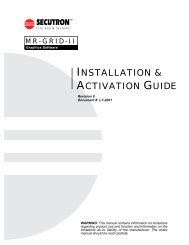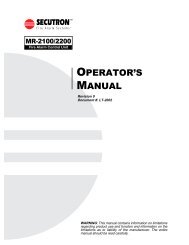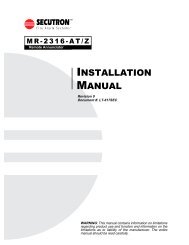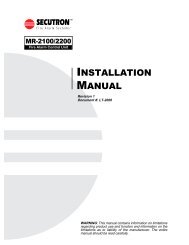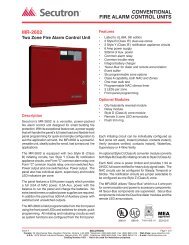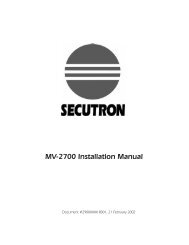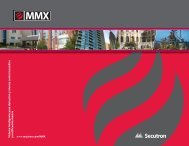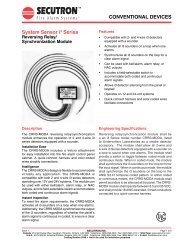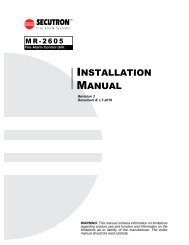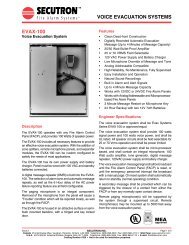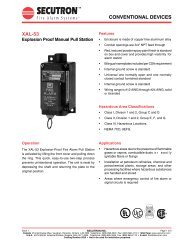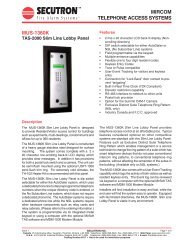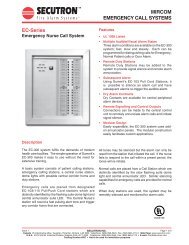You also want an ePaper? Increase the reach of your titles
YUMPU automatically turns print PDFs into web optimized ePapers that Google loves.
<strong>MRDL</strong><br />
Dual Line Dialer<br />
I NSTALLATION<br />
M ANUAL<br />
Rev i sion 1 030308<br />
Document #: LT-2021<br />
WARNING : This manual contains information on limitations<br />
regarding product use and function and information on the<br />
limitations as to liability of the manufacturer. The entire<br />
manual should be read carefully.
Table of Contents<br />
<strong>MRDL</strong> Dual Line DIaler Installation Manual<br />
1.0 Introduction ............................................................................................................................................ 1<br />
1.1 General Features of the HS3DL ....................................................................................................... 1<br />
1.2 Codes, Standards and Installation Requirements .............................................................................1<br />
1.3 Technical Support and General Information ..................................................................................... 1<br />
1.4 System Verification ........................................................................................................................... 1<br />
1.5 Standby Power ................................................................................................................................. 2<br />
2.0 Installing and Wiring the HS3DL ............................................................................................................ 3<br />
2.1 Unpacking the HS3DL ...................................................................................................................... 3<br />
2.2 Mounting & Wiring the HS3DL .......................................................................................................... 3<br />
3.0 HS3DL Operation ................................................................................................................................... 4<br />
3.1 LED Indicators .................................................................................................................................. 4<br />
3.2 Communication with the Fire Alarm Control Panel ........................................................................... 4<br />
3.3 Phone Line Communication .............................................................................................................. 4<br />
4.0 Programming the HS3DL ....................................................................................................................... 5<br />
4.1 Accessing the Dialer Settings ........................................................................................................... 5<br />
4.2 Dialer Settings .................................................................................................................................. 6<br />
5.0 Appendix A: Table of Reporting Codes ................................................................................................. 11<br />
5.1 Contact ID ........................................................................................................................................ 11<br />
5.2 SIA Format – Level 2 (Hardcoded) .................................................................................................. 11<br />
6.0 Appendix B: Table of Compatible Receivers ........................................................................................ 14<br />
7.0 Warranty Procedure .............................................................................................................................. 15<br />
8.0 FCC Compliance Statement ................................................................................................................. 16<br />
List of Figures<br />
Figure 1: <strong>MRDL</strong> Install Location ................................................................................................................... 3<br />
Figure 2: Initial Programmer Screen ............................................................................................................ 5<br />
Figure 3: Panels Screen .............................................................................................................................. 5<br />
Figure 4: Dialer Settings Button ................................................................................................................... 6<br />
Figure 5: Initial Dialer Screen ....................................................................................................................... 6<br />
Figure 6: Dialer Configuration 1 .................................................................................................................... 7<br />
Figure 7: Dialer Configuration 2 .................................................................................................................... 9<br />
Figure 8: Call Directions ............................................................................................................................... 9<br />
Figure 9: Zone Data .................................................................................................................................... 10<br />
i
1.0 Introduction<br />
<strong>MRDL</strong> Dual Line DIaler Installation Manual<br />
The <strong>MRDL</strong> is a dual line dialer that will communicate all alarms, supervisory and trouble conditions<br />
to a Central Station using Contact ID or SIA communication formats. The <strong>MRDL</strong> will support the<br />
MR-2100 and MR-2200 Fire Panels. The MHI_V21 or greater programmer must be used to<br />
program the <strong>MRDL</strong> Dialer.<br />
1.1 General Features of the <strong>MRDL</strong><br />
• Supports all zone alarm, supervisory, and trouble conditions<br />
• Supports all panel troubles<br />
• Programmable through MHI_V21 or greater programmer<br />
• Supports SIA, Contact ID, and Pager Formats<br />
• Three telephone numbers<br />
• Fully programmable test transmission<br />
• Automatic reporting codes for SIA and Contact ID formats<br />
• 128 Event buffer with date and time stamp<br />
• Communicator call directions by group<br />
• Swinger shutdown options available for all events<br />
• Module current rating: 40mA standby / 65mA when dialing<br />
• Module voltage rating: 19 VDC to 27.5 VDC<br />
1.2 Codes, Standards and Installation Requirements<br />
Relevant Codes and Standards<br />
The <strong>MRDL</strong> Dual-Line Digital Dialer is designed to meet the DACT requirements of NFPA 72, UL<br />
864 Rev.9, Control Units for fire Protective Systems.<br />
General Installation Requirements<br />
Manufacturer’s Documents<br />
When installing the <strong>MRDL</strong>, refer to this manual and the manual for the control panel into which this<br />
module is being installed. This dialer requires programming. Programming is done using the<br />
MHI_V21 or greater programming.<br />
Field Wiring<br />
Field wiring recommendations in these documents are intended as guidelines. All field wiring must<br />
be installed in accordance with NFPA 70 National Electrical Code and with all relevant local codes<br />
and standards and the Authority Having Jurisdiction.<br />
1.3 Technical Support and General Information<br />
For technical support call toll free at 1-888-SECUTRON.<br />
For general product information visit our web site: www.secutron.com.<br />
1.4 System Verification<br />
The complete fire alarm system must be verified for proper installation and operation when:<br />
• the initial installation is ready for inspection by the Local Authority Having Jurisdiction;<br />
• any system component is added, changed or deleted;<br />
• any programming changes are made;<br />
• system wiring has been altered or repaired;<br />
• system failure due to external influences such as lightning, water damage or extended<br />
power outages has occurred.<br />
1
<strong>MRDL</strong> Dual Line DIaler Installation Manual<br />
2<br />
1.5 Standby Power<br />
The MR-2100/MR-2200 Fire Panel provides standby battery support for lead-acid rechargeable<br />
batteries. The required capacity of the standby batteries must be calculated using the charts and<br />
tables within the MR-2100/MR-2200 Installation Manual (LT-2000) for the period as required by<br />
national or local codes and standards. Even though the calculation table within the MR-2100/MR-<br />
2200 Installation Manual (LT-2000) includes a safety margin, lead-acid batteries commonly used<br />
for standby can have variable capacity as a result of age and ambient conditions. Periodic<br />
inspection for damage and the batteries’ ability to support the attached equipment is highly<br />
recommended.
2.0 Installing and Wiring the <strong>MRDL</strong><br />
2.1 Unpacking the <strong>MRDL</strong><br />
The basic <strong>MRDL</strong> package includes the following components:<br />
• Dialer<br />
• 4-pin polarized locking cable assembly<br />
• Four #4 mounting screws<br />
• Installation manual<br />
2.2 Mounting & Wiring the <strong>MRDL</strong><br />
<strong>MRDL</strong> Dual Line DIaler Installation Manual<br />
Note: Ensure that standby calculations are done before installing the dialer. See the MR-2100/<br />
MR-2200 Fire Panel Installation Manual for all power information and calculation charts. The<br />
current rating for the <strong>MRDL</strong> is:<br />
• 40 mA standby current<br />
• 65 mA alarm current (when dialing)<br />
Mounting & Wiring the <strong>MRDL</strong><br />
The <strong>MRDL</strong> is mounted in the upper right corner of the back box, in the main panel. Route the<br />
wiring harness under the plastic shield before mounting the DACT. Attach the harness to the<br />
connector labeled DACT/CITY on the main board. Orient the dialer so that the mounting hole with<br />
the metal plating is located on the upper right. Position the dialer on the back box and secure with<br />
four #4 mounting screws (included). Attach the unconnected end of the wiring harness to the<br />
<strong>MRDL</strong>. The <strong>MRDL</strong> requires connection of the Secur-bus from the dialer to the main panel using<br />
the provided 4-pin polarized locking cable assembly. Two telephone lines are connected to the Tip/<br />
Ring terminals.<br />
The wiring harness for<br />
the Dialer is routed<br />
under the plastic<br />
shield.<br />
Dialer<br />
Figure 1: <strong>MRDL</strong> Install Location<br />
Metal plated<br />
mounting hole.<br />
3
<strong>MRDL</strong> Dual Line DIaler Installation Manual<br />
3.0 <strong>MRDL</strong> Operation<br />
4<br />
3.1 LED Indicators<br />
The dialer’s operating status is visible from its five LED indicators. These indicators are located on<br />
the dialer. Each indicator is described in the following table:<br />
# Indicator LED Color Activates when...<br />
1 Secur-bus<br />
Fault<br />
2 TLM2<br />
Trouble<br />
3 TLM1<br />
Trouble<br />
4 FTC<br />
Trouble<br />
3.2 Communication with the Fire Alarm Control Panel<br />
When connected to the FACP properly, the Watchdog LED will flash at a rate of ½ second on/off<br />
when power is applied to the FACP. The dedicated dialer will transmit all events that occur on the<br />
FACP if programmed to do so. Any troubles that occur on the dedicated dialer will be shown on the<br />
appropriate LED and communicated (if enabled) as well as causing a common trouble condition<br />
on the FACP. If the FACP should lose communication with the dialer a common trouble condition<br />
will also be generated.<br />
3.3 Phone Line Communication<br />
Yellow the Secur-bus connection to the main panel has<br />
failed<br />
Yellow there is a trouble on telephone line #2<br />
Yellow there is a trouble on telephone line #1<br />
Yellow the dialer is unable to communicate<br />
5 Watchdog Green the dialer is functioning normally; LED flashes<br />
½ second on, ½ second off<br />
The dedicated dialer is equipped with two phone line connections. When an event occurs that<br />
initiates communications, the first attempt at dialing will be on the programmed telephone line.<br />
Refer to “Dialer Configuration” later in this manual for dialing attempts and operation.
4.0 Programming the <strong>MRDL</strong><br />
4.1 Accessing the Dialer Settings<br />
1. At the initial programming screen (Figure 2), do the following:<br />
a. Check the Enforce Group Associations Checking box.<br />
b. Click on the Alarm List Mode list box and select the Local option.<br />
c. Click on the Panels button to access the Panels screen (Figure 3).<br />
Figure 2: Initial Programmer Screen<br />
<strong>MRDL</strong> Dual Line DIaler Installation Manual<br />
5
<strong>MRDL</strong> Dual Line DIaler Installation Manual<br />
6<br />
4.2 Dialer Settings<br />
2. In the Panels screen (Figure 3), click on the IDs button to access the IDs dialog (Figure4).<br />
In the IDs dialog (Figure 4), check the <strong>MRDL</strong> check box and click on the Dialer Settings<br />
button.<br />
Figure 3: Panels Screen<br />
Figure 4: Dialer Settings Button<br />
ID<br />
Button<br />
The Dialer Settings dialog allows for the programming of various communications options.<br />
The 1st, 2nd and 3rd Telephone Numbers can be up to 32 digits. Special digits may be used to<br />
perform the following functions:<br />
• HEX (B)-simulates the [*] key<br />
• HEX (C)-simulates the [#] key<br />
• HEX (D)-forces the panel to search for dial tone<br />
• HEX (E)-forces the panel to pause for 2 seconds<br />
• HEX (F)-end of telephone number marker<br />
Note: A Hex D is required before the number, example: D9054704070<br />
The 1st and 2nd Account Codes identify the system to the central station when a communication is<br />
sent. The code can be programmed for up to four digits. The first and third telephone number<br />
transmit the first account code. The second telephone number transmits the second account code.
The 1st and 2nd Format setting<br />
affects the type of<br />
communication that the dialer<br />
sends to the central station. The<br />
formats available include<br />
Contact ID, SIA and a pager<br />
format.<br />
The Dialer Settings window has<br />
the following push buttons along<br />
the right side:<br />
<strong>MRDL</strong> Dual Line DIaler Installation Manual<br />
• Exit: Close the Dialer<br />
Settings window and<br />
return to the IDs window.<br />
• Configuration 1:<br />
Display the Dialer<br />
Configuration 1 screen.<br />
• Configuration 2:<br />
Display the Dialer<br />
Figure 5: Initial Dialer Screen<br />
Configuration 2 screen.<br />
• Zone Data: Display the<br />
Zone Data screen.<br />
• Maintenance/Common: Display the Dialer Maintenance and Common Reporting Codes<br />
screen.<br />
Dialer Configuration 1<br />
The Dialer Configuration 1 dialog contains the First Communicator Options, Second<br />
Communicator Options and International Options. The Communications option determines if the<br />
dialer will communicate to the central station. When Enabled is selected, the dialer will<br />
communicate all events as programmed. When Disabled is selected, the dialer will not<br />
communicate any events.<br />
The TLM One/Two Check options determine whether the dialer will test for telephone line faults on<br />
line one and line two respectively.<br />
The Third Phone # can be programmed for two different modes of operation. When Alternate<br />
Dialing Enabled is selected, the dialer switches between the first and third numbers after each<br />
dialing attempt, until the maximum number of dialing attempts have been made to each number.<br />
When Third Number Backup is enabled, the dialer will use the third number only if all attempts to<br />
communicate to the first number fail. If all attempts to communicate to the third number also fail, a<br />
failure to communicate trouble will be generated. When Disabled is selected, the third telephone<br />
number is not used.<br />
7
<strong>MRDL</strong> Dual Line DIaler Installation Manual<br />
8<br />
The Dialing option has three<br />
different options for pulse or<br />
DTMF dialing. If All attempts<br />
Pulse is selected, the dialer<br />
will always use pulse (rotary)<br />
dialing. If All attempts DTMF<br />
Dialing is selected, the dialer<br />
will always use DTMF dialing.<br />
If 4 attempts DTMF then Pulse<br />
is selected, the dialer will use<br />
DTMF dialing for the first four<br />
attempts. If unsuccessful, the<br />
dialer will switch to pulse<br />
dialing for the remaining<br />
attempts.<br />
The SIA Rep. Codes option Figure 6: Dialer Configuration 1<br />
determines whether the dialer<br />
will send automatic reporting<br />
codes, or use the reporting codes that are programmed in the Zone Data and Maintenance/<br />
Common reporting codes sections. See “5.0 Appendix A: Table of Reporting Codes” on page 11<br />
for a list of the automatic SIA Reporting Codes.<br />
The SIA Max Events option sets the maximum number of events the dialer will send for one SIA<br />
transmission. When 20 per Round is selected, SIA sends a maximum of 20 events per round.<br />
When 8 per Round is selected, SIA sends maximum of 8 events per round.<br />
The Contact ID Rep. Codes option determines whether the dialer will send automatic reporting<br />
codes, or use the values that are programmed in the Zone Data and Maintenance/Common<br />
reporting codes sections. See “5.0 Appendix A: Table of Reporting Codes” on page 11 for a list of<br />
the automatic Contact ID Reporting Codes.<br />
Pager Format. Events will be communicated to a pager when using this format. When<br />
programming a pager telephone number, extra digits must be used in order for the feature to<br />
function properly. Program two hexadecimal digits 'E' at the end of the number (4 second pause).<br />
The panel will attempt to call the pager one time. After dialing the digits in the telephone number<br />
the panel will send the account number and reporting code followed by the [#] key (Hex [C]). There<br />
is no ringback when using Pager format. The panel has no way of confirming if the paging attempt<br />
was successful. Do not use hexadecimal C in a reporting code when using pager format. In most<br />
cases the digit C will be interpreted as a [*], which will terminate the page before it has finished.<br />
Example: D19787319876EE<br />
The Test Transmission Line option determines how the dialer chooses a telephone line to send the<br />
automatic test transmission. If Alternate is selected, the dialer will alternate between using lines 1<br />
and 2 for transmissions, regardless of telephone line troubles. If Available is selected, the dialer<br />
will use Line 1 for test transmissions. If a trouble exists on Line 1, the dialer will switch to Line 2.<br />
When the Force Dialing option is set to enabled, if the first attempt by the panel to call the<br />
monitoring station fails, on every subsequent attempt the panel will dial regardless of the presence<br />
of dial tone. When Disabled is selected, the panel will not dial the programmed telephone number<br />
if dial tone is not present.<br />
When the Busy Tone Detection option is enabled, if busy tone is detected, the dialer will disengage<br />
the phone line and try to place the call again following the delay between dialing attempts. When<br />
Disabled is selected, the dialer will use the standard dialing procedure for every attempt. The<br />
Pulse Make/Break Ratio option is for panels in international applications. When 40/60 is selected,<br />
the pulse dialing make/break ratio is the 40/60, and when 33/67 is selected it is 33/67.
<strong>MRDL</strong> Dual Line DIaler Installation Manual<br />
The ID Tone can be set to 1300Hz or 2100 Hz. The panel will emit a tone at the selected frequency<br />
for 500 ms every 2 seconds when it places a call to indicate that it is a digital equipment call, not<br />
voice. When Disabled is selected, this feature will not be used.<br />
Dialer Configuration 2<br />
The Dialer Configuration 2 screen contains the Swinger Shutdown Variables, Other Options and<br />
Test Transmission options. The Swinger Shutdown options determine the maximum number of<br />
zone and trouble events that the dialer will transmit in one day. The alarm or trouble will still be<br />
displayed on the panel and logged in the archive, but the dialer will not transmit the event. There<br />
are individual counters for Zone Alarm and Restore, Zone Supervisory and Restore, Zone Trouble<br />
and Restore and Maintenance Trouble and Restore. This feature will be reset at midnight. To<br />
disable the feature, program 000.<br />
The Test Transmission Time of Day determines when the automatic test transmission will occur.<br />
The entry is four digits, military 24 hour format (HH:MM). To disable the feature, program the time<br />
as [9999]. The Test Transmission Cycle determines the number of days between test<br />
transmissions.<br />
The TLM Trouble Delay<br />
controls the number of<br />
telephone line monitoring<br />
checks required before a<br />
telephone line trouble is<br />
generated. The dialer<br />
checks the telephone<br />
connection at 10-second<br />
intervals. The Maximum<br />
Dialing Attempts to Each<br />
Phone Number is the<br />
number of attempts that the<br />
dialer will make to each<br />
telephone number before<br />
generating a fail to<br />
communicate trouble. Post<br />
Dial Wait for Handshake is<br />
the amount of time the<br />
dialer will wait for a valid<br />
Figure 7: Dialer Configuration 2<br />
initial handshake from the receiver after dialing the programmed telephone number.<br />
The Call Directions dialog<br />
contains the options that<br />
determine which telephone<br />
numbers will be used to<br />
communicate events. There are<br />
five different types of events that<br />
can each be sent to telephone<br />
number one or telephone<br />
number two. The event types are<br />
Fire Zone Alarm/Restore,<br />
Supervisory Zone Alarm/<br />
Restore, Zone Trouble/Restore,<br />
Maintenance Trouble/Restore<br />
and Test Transmissions.<br />
Figure 8: Call Directions<br />
9
<strong>MRDL</strong> Dual Line DIaler Installation Manual<br />
10<br />
The Zone Data dialog (Figure 9) contains zone definitions and reporting codes that the dialer will<br />
use to communicate events.<br />
The Groups List is a list of all currently defined groups. Each line entry includes the Group ID and<br />
its message/description. Click on the desired group in order to program it.<br />
The Definition specifies the identifier of the alarm or trouble being sent to the central station. The<br />
zone types that are available are Fire, Sprinkler, Heat, Water and Untyped.<br />
The Reporting Codes are used when SIA or Contact ID is set to Programmed, or when using BPS<br />
formats. There are six reporting codes for each group. They are:<br />
• Zone Alarm Reporting<br />
Code<br />
• Zone Alarm Restoral<br />
Reporting Code<br />
• Trouble Reporting<br />
Code<br />
• Trouble Restoral<br />
Reporting Code<br />
• Supervisory Reporting<br />
Code<br />
• Supervisory Restoral<br />
Reporting Code<br />
Figure 9: Zone Data<br />
Dialer Maintenance and Common Reporting Codes<br />
The Dialer Maintenance and Common Reporting Codes dialog contains maintenance and<br />
common reporting codes that the dialer will use to communicate those events.<br />
The Reporting Codes List is a list<br />
of all available maintenance and<br />
common reporting codes. Select<br />
one to program its reporting<br />
code. The Reporting Codes are<br />
used when SIA or Contact ID is<br />
set to Programmed, or when<br />
using BPS formats. There are<br />
many different reporting codes in<br />
this group.<br />
Figure 10: Reporting Codes
5.0 Appendix A: Table of Reporting Codes<br />
<strong>MRDL</strong> Dual Line DIaler Installation Manual<br />
The following tables contain automatic Contact ID and SIA format reporting codes. For more<br />
information on reporting formats.<br />
5.1 Contact ID<br />
The first digit (in parentheses) will automatically be sent by the control. The second two digits are<br />
programmed to indicate specific information about the signal.<br />
For example, if zone 1 is an fire zone point, you could program the event code as [1A]. The central<br />
station would receive the following:<br />
*FIRE* - FIRE ALARM - 1<br />
where the “1” indicates which zone went into alarm.<br />
5.2 SIA Format – Level 2 (Hardcoded)<br />
The SIA communication format used in this product follows the Level 2 specifications of the SIA<br />
Digital Communication Standard – October 1997. This format will send the account code along<br />
with its data transmission. The transmission would look similar to the following at the receiver:<br />
N Ri00 FA 01<br />
N = New Event<br />
Ri00 = System Event<br />
FA = Fire Alarm<br />
01 = Zone 1<br />
11
<strong>MRDL</strong> Dual Line DIaler Installation Manual<br />
12<br />
Table 1: Automatic Contact ID/SIA Reporting Codes<br />
Reporting<br />
Code<br />
Zone Supv./<br />
Rest.<br />
Zone Alarms/<br />
Rest.<br />
Zone Trouble/<br />
Rest.<br />
AC Fail Trouble/<br />
Rest.<br />
Battery Trouble/<br />
Rest.<br />
Ground Fault<br />
Trouble/Rest.<br />
NAC Trouble/<br />
Rest.<br />
General System<br />
Trouble/Rest.<br />
Gen. System<br />
Supervisory/<br />
Rest.<br />
Secur-bus<br />
Trouble/Rest.<br />
Line 1 or 2 TLM<br />
Trouble/Rest.<br />
Phone # 1 or 2<br />
FTC Trouble/<br />
Rest.<br />
Walk Test Start/<br />
Stop<br />
Installer Lead In/<br />
Out<br />
Test<br />
Transmission<br />
Normal/Off-<br />
Normal<br />
Code Sent When…<br />
Dialer<br />
Direction*<br />
Contact<br />
ID Auto<br />
Rep<br />
Codes<br />
* Call directions: A/R = alarm/restoral; T/R = trouble/restoral; MA/R = maintenance alarm/restoral; S/R =<br />
supervisory/restore; T = test transmission<br />
** Line number/telephone number is identified (XX)<br />
Sia Auto<br />
Rep Codes<br />
zone goes into supervisory/ restore S/R (2) AA See Table 3<br />
zone goes into alarm/ alarm condition has<br />
been restored<br />
zone exhibits a trouble condition/ zone<br />
trouble condition has been restored<br />
AC power to control panel is disconnected or<br />
interrupted/AC power restored; both codes<br />
follow the AC Trouble Delay<br />
A/R (1) 3A See Table 3<br />
T/R (3) 73 See Table 3<br />
MA/R (3) A1 AT-00/AR-00<br />
control panel battery is low/battery restored MA/R (3) A2 YT-00/YR-00<br />
Earth Ground Fault is detected/restored MA/R (3) 1A UT-OO/UJ-00<br />
NAC circuit is opened/restored MA/R (3) 21 YA-99/YH-99<br />
module trouble is detected/restored MA/R (3) 3A YX-00/YZ-00<br />
control panel loses/restores communications<br />
to enrolled modules<br />
MA/R (3) 33 ET-00/ER-00<br />
Secur-bus connection is lost/restored MA/R (3) 33 NT-00/NR-00<br />
connection via Telephone Numbers 1 or 2 is<br />
lost/restored<br />
communication is restored after a failure to<br />
communicate trouble has occurred; events<br />
not communicated during lapse will also be<br />
sent<br />
control panel has entered/exited walk test<br />
mode; no events will be communicated<br />
control panel enters/exits programming<br />
mode<br />
test transmission reports system normal or<br />
off-normal (alarm, supervisory or trouble)<br />
control panel condition<br />
MA/R (3) 51 LT-XX/LR-XX**<br />
MA/R (3) 54 YC-XX/YK-XX**<br />
MA/R (6) A7 TS-00/TE-00<br />
MA/R (6) 27/28 LB-00/LX-00<br />
T (6) A2 RP-00/RY-00
<strong>MRDL</strong> Dual Line DIaler Installation Manual<br />
Table 2: Contact ID Zone Alarm/Restoral Event Codes<br />
Program any of these codes for zone alarms/restorals when using the standard (i.e. not automatic)<br />
Contact ID reporting format:<br />
Medical Alarms (1)18 Near Alarm 24 Hour Non-Fire<br />
(1)A1 Emergency Panic Alarms (1)51 Gas Detected<br />
(1)A2 Fail to Report In (1)2A Panic (1)52 Refrigeration<br />
Fire Alarms (1)21 Duress (1)53 Loss of Heat<br />
(1)1A Fire Alarm (1)22 Silent (1)54 Water Leakage<br />
(1)11 Smoke (1)23 Audible (1)55 Foil Break<br />
(1)12 Combustion General Alarms (1)56 Day Trouble<br />
(1)13 Water Flow (1)4A General Alarm (1)57 Low Bottled Gas Level<br />
(1)14 Heat (1)4A General Alarm (1)58 High Temp<br />
(1)15 Pull Station (1)43 Expansion module failure (1)59 Low Temp<br />
(1)16 Duct (1)44 Sensor tamper (1)61 Loss of Air Flow<br />
(1)17 Flame (1)45 Module Tamper<br />
Table 3: SIA Format Automatic Zone Alarm/Restoral Codes<br />
Zone<br />
Definition<br />
ZZ = zones 01-05<br />
Alarm/Rest.<br />
Rep Codes*<br />
Trouble/<br />
Rest.<br />
Rep Codes<br />
Zone<br />
Definition<br />
SIA Auto<br />
Rep Codes*<br />
Trouble/<br />
Rest. Rep<br />
Codes<br />
[00] Null Zone No transm. No transm. [09] Gas GA-ZZ/GH-ZZ GT-ZZ/GJ-ZZ<br />
[01] Fire FA-ZZ/FH-ZZ FT-ZZ/FJ-ZZ [10] Freeze ZA-ZZ/ZH-ZZ ZT-ZZ/ZJ-ZZ<br />
[02] Fire<br />
Supervisory<br />
FS-ZZ/FR-ZZ FT-ZZ/FJ-ZZ [11] Heat KA-ZZ/KH-ZZ KT-ZZ/KJ-ZZ<br />
[03] Sprinkler SA-ZZ/SH-ZZ ST-ZZ/SJ-ZZ [12] Water WA-ZZ/WH-ZZ WT-ZZ/WJ-ZZ<br />
[06] Panic PA-ZZ/PH-ZZ PT-ZZ/PJ-ZZ [13] Untyped UA-ZZ/UH-ZZ UT-ZZ/UJ-ZZ<br />
[07] Emergency QA-ZZ/QH/ZZ QT-ZZ/QJ/ZZ<br />
13
<strong>MRDL</strong> Dual Line DIaler Installation Manual<br />
6.0 Appendix B: Table of Compatible Receivers<br />
Pager format is to be used for backup troubles only.<br />
14<br />
Format/<br />
Receiver<br />
Sur-Gard<br />
SLR<br />
Sur-Gard<br />
MLR<br />
Sur-Gard<br />
MLR200<br />
0<br />
Osbourne<br />
Hoffman<br />
Quick<br />
Alert II<br />
Silent<br />
Knight<br />
Ademco<br />
685<br />
Radionics<br />
6500<br />
Bell<br />
Mobility<br />
Pager<br />
SIA (level 2) Yes Yes Yes Yes Yes<br />
Contact ID Yes Yes Yes Yes Yes<br />
Pager N/A N/A N/A N/A N/A N/A N/A Yes<br />
Version V1.00 V1.83 V1.2 2/20/96 SIA- Rev4.4d D6500 L/C<br />
9004I-<br />
960626<br />
1993
7.0 Warranty & Warning Information<br />
Warning Please Read Carefully<br />
Note to End Users: This equipment is subject to terms and conditions of sale as follows:<br />
<strong>MRDL</strong> Dual Line DIaler Installation Manual<br />
Note to Installers<br />
This warning contains vital information. As the only individual in contact with system users, it is your responsibility to bring<br />
each item in this warning to the attention of the users of this system. Failure to properly inform system end-users of the<br />
circumstances in which the system might fail may result in over-reliance upon the system. As a result, it is imperative that<br />
you properly inform each customer for whom you install the system of the possible forms of failure.<br />
System Failures<br />
This system has been carefully designed to be as effective as possible. There are circumstances, such as fire or other types<br />
of emergencies where it may not provide protection. Alarm systems of any type may be compromised deliberately or may<br />
fail to operate as expected for a variety of reasons. Some reasons for system failure include:<br />
•Inadequate Installation<br />
A Fire Alarm system must be installed in accordance with all the applicable codes and standards in order to provide<br />
adequate protection. An inspection and approval of the initial installation, or, after any changes to the system, must be<br />
conducted by the Local Authority Having Jurisdiction. Such inspections ensure installation has been carried out properly.<br />
•Power Failure<br />
Control units, smoke detectors and many other connected devices require an adequate power supply for proper operation. If<br />
the system or any device connected to the system operates from batteries, it is possible for the batteries to fail. Even if the<br />
batteries have not failed, they must be fully charged, in good condition and installed correctly. If a device operates only by<br />
AC power, any interruption, however brief, will render that device inoperative while it does not have power. Power<br />
interruptions of any length are often accompanied by voltage fluctuations which may damage electronic equipment such as<br />
a fire alarm system. After a power interruption has occurred, immediately conduct a complete system test to ensure that the<br />
system operates as intended.<br />
•Failure of Replaceable Batteries<br />
Systems with wireless transmitters have been designed to provide several years of battery life under normal conditions. The<br />
expected battery life is a function of the device environment, usage and type. Ambient conditions such as high humidity, high<br />
or low temperatures, or large temperature fluctuations may reduce the expected battery life. While each transmitting device<br />
has a low battery monitor which identifies when the batteries need to be replaced, this monitor may fail to operate as<br />
expected. Regular testing and maintenance will keep the system in good operating condition.<br />
•Compromise of Radio Frequency (Wireless) Devices<br />
Signals may not reach the receiver under all circumstances which could include metal objects placed on or near the radio<br />
path or deliberate jamming or other inadvertent radio signal interference.<br />
•System Users<br />
A user may not be able to operate a panic or emergency switch possibly due to permanent or temporary physical disability,<br />
inability to reach the device in time, or unfamiliarity with the correct operation. It is important that all system users be trained<br />
in the correct operation of the alarm system and that they know how to respond when the system indicates an alarm.<br />
•Automatic Alarm Initiating Devices<br />
Smoke detectors, heat detectors and other alarm initiating devices that are a part of this system may not properly detect a<br />
fire condition or signal the control panel to alert occupants of a fire condition for a number of reasons, such as: the smoke<br />
detectors or heat detector may have been improperly installed or positioned; smoke or heat may not be able to reach the<br />
alarm initiating device, such as when the fire is in a chimney, walls or roofs, or on the other side of closed doors; and, smoke<br />
and heat detectors may not detect smoke or heat from fires on another level of the residence or building.<br />
•Software<br />
Most <strong>Secutron</strong> products contain software. With respect to those products, <strong>Secutron</strong> does not warranty that the operation of<br />
the software will be uninterrupted or error-free or that the software will meet any other standard of performance, or that the<br />
functions or performance of the software will meet the user’s requirements. <strong>Secutron</strong> shall not be liable for any delays,<br />
breakdowns, interruptions, loss, destruction, alteration or other problems in the use of a product arising our of, or caused by,<br />
15
<strong>MRDL</strong> Dual Line DIaler Installation Manual<br />
16<br />
the software.<br />
Every fire is different in the amount and rate at which smoke and heat are generated. Smoke detectors cannot sense all<br />
types of fires equally well. Smoke detectors may not provide timely warning of fires caused by carelessness or safety<br />
hazards such as smoking in bed, violent explosions, escaping gas, improper storage of flammable materials, overloaded<br />
electrical circuits, children playing with matches or arson.<br />
Even if the smoke detector or heat detector operates as intended, there may be circumstances when there is insufficient<br />
warning to allow all occupants to escape in time to avoid injury or death.<br />
•Alarm Notification Appliances<br />
Alarm Notification Appliances such as sirens, bells, horns, or strobes may not warn people or waken someone sleeping if<br />
there is an intervening wall or door. If notification appliances are located on a different level of the residence or premise, then<br />
it is less likely that the occupants will be alerted or awakened. Audible notification appliances may be interfered with by other<br />
noise sources such as stereos, radios, televisions, air conditioners or other appliances, or passing traffic. Audible notification<br />
appliances, however loud, may not be heard by a hearing-impaired person.<br />
•Telephone Lines<br />
If telephone lines are used to transmit alarms, they may be out of service or busy for certain periods of time. Also the<br />
telephone lines may be compromised by such things as criminal tampering, local construction, storms or earthquakes.<br />
•Insufficient Time<br />
There may be circumstances when the system will operate as intended, yet the occupants will not be protected from the<br />
emergency due to their inability to respond to the warnings in a timely manner. If the system is monitored, the response may<br />
not occur in time enough to protect the occupants or their belongings.<br />
•Component Failure<br />
Although every effort has been made to make this system as reliable as possible, the system may fail to function as<br />
intended due to the failure of a component.<br />
•Inadequate Testing<br />
Most problems that would prevent an alarm system from operating as intended can be discovered by regular testing and<br />
maintenance. The complete system should be tested as required by national standards and the Local Authority Having<br />
Jurisdiction and immediately after a fire, storm, earthquake, accident, or any kind of construction activity inside or outside<br />
the premises. The testing should include all sensing devices, keypads, consoles, alarm indicating devices and any other<br />
operational devices that are part of the system.<br />
•Security and Insurance<br />
Regardless of its capabilities, an alarm system is not a substitute for property or life insurance. An alarm system also is not<br />
a substitute for property owners, renters, or other occupants to act prudently to prevent or minimize the harmful effects of an<br />
emergency situation.<br />
IMPORTANT NOTE: End-users of the system must take care to ensure that the system, batteries, telephone lines, etc. are<br />
tested and examined on a regular basis to ensure the minimization of system failure.
Limited Warranty<br />
<strong>MRDL</strong> Dual Line DIaler Installation Manual<br />
<strong>Secutron</strong> Inc. warrants the original purchaser that for a period of two years from the date of manufacture, the product shall<br />
be free of defects in materials and workmanship under normal use. During the warranty period, <strong>Secutron</strong> Inc. shall, at its<br />
option, repair or replace any defective product upon return of the product to its factory, at no charge for labor and materials.<br />
Any replacement and/or repaired parts are warranted for the remainder of the original warranty or ninety (90) days,<br />
whichever is longer. The original owner must promptly notify <strong>Secutron</strong> Inc. in writing that there is defect in material or<br />
workmanship, such written notice to be received in all events prior to expiration of the warranty period.<br />
International Warranty<br />
The warranty for international customers is the same as for any customer within Canada and the United States, with the<br />
exception that <strong>Secutron</strong> Inc. shall not be responsible for any customs fees, taxes, or VAT that may be due.<br />
Conditions to Void Warranty<br />
This warranty applies only to defects in parts and workmanship relating to normal use. It does not cover:<br />
•damage incurred in shipping or handling;<br />
•damage caused by disaster such as fire, flood, wind, earthquake or lightning;<br />
•damage due to causes beyond the control of <strong>Secutron</strong> Inc. such as excessive voltage, mechanical shock or<br />
•water damage;<br />
•damage caused by unauthorized attachment, alterations, modifications or foreign objects;<br />
•damage caused by peripherals (unless such peripherals were supplied by <strong>Secutron</strong> Inc.);<br />
•defects caused by failure to provide a suitable installation environment for the products;<br />
•damage caused by use of the products for purposes other than those for which it was designed;<br />
•damage from improper maintenance;<br />
•damage arising out of any other abuse, mishandling or improper application of the products.<br />
Warranty Procedure<br />
To obtain service under this warranty, please return the item(s) in question to the point of purchase. All authorized<br />
distributors and dealers have a warranty program. Anyone returning goods to <strong>Secutron</strong> Inc. must first obtain an<br />
authorization number. <strong>Secutron</strong> Inc. will not accept any shipment whatsoever for which prior authorization has not been<br />
obtained. NOTE: Unless specific pre-authorization in writing is obtained from <strong>Secutron</strong> management, no credits will be<br />
issued for custom fabricated products or parts or for complete fire alarm system. <strong>Secutron</strong> will at its sole option, repair or<br />
replace parts under warranty. Advance replacements for such items must be purchased.<br />
Note: <strong>Secutron</strong> Inc.’s liability for failure to repair the product under this warranty after a reasonable number of attempts will<br />
be limited to a replacement of the product, as the exclusive remedy for breach of warranty.<br />
Disclaimer of Warranties<br />
This warranty contains the entire warranty and shall be in lieu of any and all other warranties, whether expressed or implied<br />
(including all implied warranties of merchantability or fitness for a particular purpose) And of all other obligations or liabilities<br />
on the part of <strong>Secutron</strong> Inc. neither assumes nor authorizes any other person purporting to act on its behalf to modify or to<br />
change this warranty, nor to assume for it any other warranty or liability concerning this product.<br />
This disclaimer of warranties and limited warranty are governed by the laws of the province of Ontario, Canada.<br />
17
<strong>MRDL</strong> Dual Line DIaler Installation Manual<br />
Out of Warranty Repairs<br />
18<br />
<strong>Secutron</strong> Inc. will at its option repair or replace out-of-warranty products which are returned to its factory according to the<br />
following conditions. Anyone returning goods to <strong>Secutron</strong> Inc. must first obtain an authorization number. <strong>Secutron</strong> Inc. will<br />
not accept any shipment whatsoever for which prior authorization has not been obtained.<br />
Products which<strong>Secutron</strong> Inc. determines to be repairable will be repaired and returned. A set fee which <strong>Secutron</strong> Inc. has<br />
predetermined and which may be revised from time to time, will be charged for each unit repaired.<br />
Products which <strong>Secutron</strong> Inc. determines not to be repairable will be replaced by the nearest equivalent product available at<br />
that time. The current market price of the replacement product will be charged for each replacement unit.<br />
WARNING: <strong>Secutron</strong> Inc. recommends that the entire system be completely tested on a regular basis.<br />
However, despite frequent testing, and due to, but not limited to, criminal tampering or electrical<br />
disruption, it is possible for this product to fail to perform as expected.<br />
NOTE: Under no circumstances shall <strong>Secutron</strong> Inc. be liable for any special, incidental, or<br />
consequential damages based upon breach of warranty, breach of contract, negligence, strict liability,<br />
or any other legal theory. Such damages include, but are not limited to, loss of profits, loss of the<br />
product or any associated equipment, cost of capital, cost of substitute or replacement equipment,<br />
facilities or services, down time, purchaser’s time, the claims of third parties, including customers, and<br />
injury to property.<br />
SECUTRON MAKES NO WARRANTY OF MERCHANTABILITY OR FITNESS FOR A PARTICULAR<br />
PURPOSE WITH RESPECT TO ITS GOODS DELIVERED, NOR IS THERE ANY OTHER WARRANTY,<br />
EXPRESSED OR IMPLIED, EXCEPT FOR THE WARRANTY CONTAINED HEREIN.
8.0 FCC Compliance Statement<br />
<strong>MRDL</strong> Dual Line DIaler Installation Manual<br />
CAUTION: Changes or modifications not expressly approved by the manufacturer could void your<br />
authority to use this equipment.<br />
This equipment has been tested and found to comply with the limits for a Class B digital device,<br />
pursuant to Part 15 of the FCC Rules. These limits are designed to provide reasonable protection<br />
against harmful interference in a residential installation. This equipment generates, uses and can<br />
radiate radio frequency energy and, if not installed and used in accordance with the instructions,<br />
may cause harmful interference to radio communications. However, there is no guarantee that<br />
interference will not occur in a particular installation. If this equipment does cause harmful<br />
interference to radio or television reception, which can be determined by turning the equipment off<br />
and on, the user is encouraged to try to correct the interference by one or more of the following<br />
measures:<br />
• Re-orient the receiving antenna.<br />
• Increase the separation between the equipment and receiver.<br />
• Connect the equipment into an outlet on a circuit different from that to which the receiver is<br />
connected.<br />
• Consult the dealer or an experienced radio/television technician for help.<br />
The user may find the following booklet prepared by the FCC useful: “How to Identify and Resolve<br />
Radio/Television Interference Problems”. This booklet is available from the U.S. Government<br />
Printing Office, Washington D.C. 20402, Stock # 004-000-00345-4.<br />
The user may find the following booklet prepared by the FCC useful: “How to Identify and Resolve<br />
Radio/Television Interference Problems”. This booklet is available from the U.S. Government<br />
Printing Office, Washington D.C. 20402, Stock # 004-000-00345-4.<br />
important information<br />
This equipment complies with Part 68 of the FCC Rules. On the side of this equipment is a label<br />
that contains, among other information, the FCC registration number of this equipment.<br />
NOTIFICATION TO TELEPHONE COMPANY The customer shall notify the telephone company<br />
of the particular line to which the connection will be made, and provide the FCC registration<br />
number and the ringer equivalence of the protective circuit.<br />
FCC Registration Number: 6OT USA-34879-AL-ERinger Equivalence Number: 0.1BUSOC Jack:<br />
RJ-31X<br />
TELEPHONE CONNECTION REQUIREMENTS Except for the telephone company provided<br />
ringers, all connections to the telephone network shall be made through standard plugs and<br />
telephone company provided jacks, or equivalent, in such a manner as to allow for easy,<br />
immediate disconnection of the terminal equipment. Standard jacks shall be so arranged that, if<br />
the plug connected thereto is withdrawn, no interference to the operation of the equipment at the<br />
customer’s premises which remains connected to the telephone network shall occur by reason of<br />
such withdrawal.<br />
INCIDENCE OF HARM Should terminal equipment or protective circuitry cause harm to the<br />
telephone network, the telephone company shall, where practicable, notify the customer that<br />
temporary disconnection of service may be required; however, where prior notice is not<br />
practicable, the telephone company may temporarily discontinue service if such action is deemed<br />
reasonable in the circumstances. In the case of such temporary discontinuance, the telephone<br />
company shall promptly notify the customer and will be given the opportunity to correct the<br />
situation.<br />
19
<strong>MRDL</strong> Dual Line DIaler Installation Manual<br />
20<br />
ADDITIONAL TELEPHONE COMPANY INFORMATION The security control panel must be<br />
properly connected to the telephone line with a USOC RJ-31X telephone jack.<br />
The FCC prohibits customer-provided terminal equipment be connected to party lines or to be<br />
used in conjunction with coin telephone service. Interconnect rules may vary from state to state.<br />
CHANGES IN TELEPHONE COMPANY EQUIPMENT OR FACILITIES The telephone company<br />
may make changes in its communications facilities, equipment, operations or procedures, where<br />
such actions are reasonably required and proper in its business. Should any such changes render<br />
the customer’s terminal equipment incompatible with the telephone company facilities the<br />
customer shall be given adequate notice to the effect modifications to maintain uninterrupted<br />
service.<br />
RINGER EQUIVALENCE NUMBER (REN) The REN is useful to determine the quantity of devices<br />
that you may connect to your telephone line and still have all of those devices ring when your<br />
telephone number is called. In most, but not all areas, the sum of the RENs of all devices<br />
connected to one line should not exceed five (5.0). To be certain of the number of devices that you<br />
may connect to your line, you may want to contact your local telephone company.<br />
EQUIPMENT MAINTENANCE FACILITY If you experience trouble with this telephone equipment,<br />
please contact the facility indicated below for information on obtaining service or repairs. The<br />
telephone company may ask that you disconnect this equipment from the network until the<br />
problem has been corrected or until you are sure that the equipment is not malfunctioning
Canada<br />
25 Interchange Way<br />
Vaughan, ON L4K 5W3<br />
Tel: (888) SECUTRON<br />
(888) 732-8876<br />
Fax: (905) 660-4113<br />
© 2007 <strong>Secutron</strong>, Inc.<br />
No part of this publication may be reproduced, transmitted,<br />
transcribed, stored in a retrieval system, or translated into<br />
any language or computer language, in any form by any<br />
means electronic, magnetic, optical, chemical, manual, or<br />
otherwise without the prior consent of <strong>Secutron</strong>.<br />
U.S.A<br />
60 Industrial Parkway, PMB 278<br />
Cheektowaga, New York 14227<br />
Tel: (888) SECUTRON<br />
(888) 732-8876<br />
Fax: (905) 660-4113




